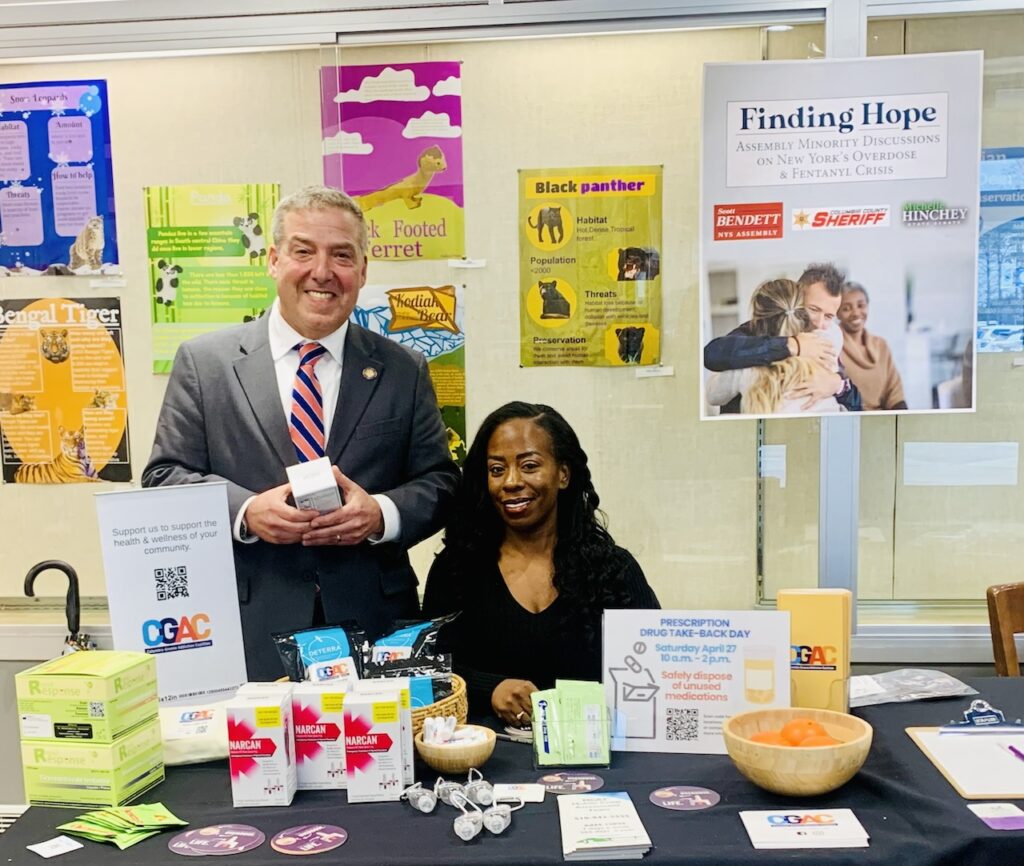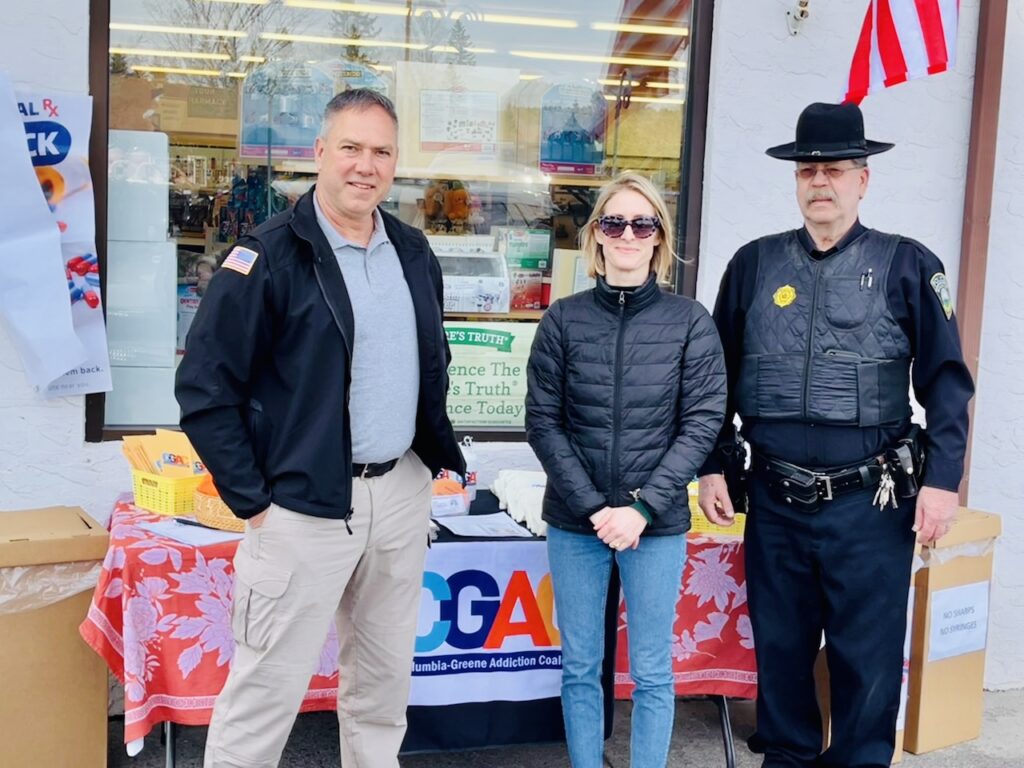Main Street News

Columbia-Greene Addiction Coalition Addresses Substance Abuse in Local Communities
According to Hannah Calhoun, the executive director of the Columbia-Greene Addiction Coalition, the organization’s main goal is to support communities affected by substance use disorder.
CGAC was first established over a decade ago in response to the opioid crisis. The creation of the coalition was initiated by Columbia Memorial Hospital in Hudson, NY, and members included a variety of government and non-government organizations in Columbia and Greene counties.
Hannah joined the coalition in 2022 as the program coordinator tasked with sustaining the efforts of the HEAL (Helping to End Addiction Long-term) Initiative, which was a large multi-state, multi-county study funded by the National Institutes of Health and led by Columbia University that identified Columbia and Greene counties in their wave one work aimed at improving prevention and treatment strategies for opioid misuse, addiction and overdose.
In 2021, Greene County ranked #1 out of 57 upstate New York counties for death involving opioids.
Similarly, Columbia County has also been greatly affected by the opioid crisis; data for both counties can be found on CGAC’s website here, which is routinely updated by the Greene County Public Health and includes data from both ODMAP (Overdose Detection Mapping Application Program) and County Coroner Data, which yields an approximate fatality rate.
“I learned very early on that in order for us to be a sustainable coalition, we needed to have funding, along with a larger community presence and awareness of the problem,” Hannah explained.
By January of 2023, Hannah took on the role of executive director and led CGAC to incorporation with a small advisory board. Also during this time, she applied for federal funding through the Center for Disease Control and Prevention and the NYS Office of Addiction Services and Support.
“To much of my surprise, CGAC was awarded both grants, totalling $1.4 million in funding over the next five years and the funding through OASAS is especially important because it is Opioid Settlement Dollars and will be used specifically for interventions in Greene County,” Hannah shared.
Now, CGAC has three employees – in addition to Hannah – all of whom have been affected in some way by substance use disorder and are passionate about addressing disproportionately affected communities in this work.

Outreach Coordinator Tiffany Garriga with Assemblymen Bendett
What are the grant funds being used for?
Much of the funds initially require CGAC to work through the strategic prevention framework to collect data and build capacity. CGAC has also been working to administer prevention-need surveys across school districts in Columbia and Greene counties, which are widely used data collection methods that measure risk and protective factors, determine local conditions and support the development and measurement of prevention initiatives.
“We’ve had a hard time rolling the surveys out,” Hannah shared. “Prevention education is taught differently from district to district, so there’s no real way to assess the effectiveness of prevention education that’s being taught now.”
CGAC is asking to do surveys in grades six, eight, ten, and twelve, and the surveys touch on issues including frequency and type of substances being used as well as mental health and violence. Hannah said that they are hoping that the surveys give insight to students’ mental health struggles so that school districts and organizations can do more to help.
“This would also give a better understanding of mental health needs in the area. The surveys would not only help enhance the prevention education already in place, but would improve it while also addressing school connectedness, suspension rates, and parent’s involvement in student’s lives, among others. That data is really important for tailoring prevention education to the needs of the students and would allow us to provide additional support in the community where necessary.”
Additionally, CGAC is partnering with local organizations to host events and workshops. On Thursday, May 23, CGAC is hosting a community narcan training and informational session in partnership with the Mental Health Association of Columbia and Greene County Youth Clubhouses. The workshop will run from 6-7pm and will be held at the Taghkanic Fire Co. in Elizaville, NY. CGAC also works with many other organizations from both sides of the river which includes Columbia County Pathways to Recovery, Mountaintop Cares Coalition and Greener Pathways Mobile Outreach Unit.
“We want to foster collaboration and coordination with other organizations that provide services that are needed in this area. When you’re working across two counties with different organizations, it’s important that we’re including populations that have been historically underserved or left out of initiatives like this,” Hannah said.
Visit CGAC’s calendar of events here to stay updated on their upcoming events.

Executive director Hannah Calhoun with Windham Police Department on Drug Take Back Day
Looking ahead
For Hannah, who is from Chatham, working with the addiction coalition has been incredibly rewarding.
“I have friends and family who have been greatly affected by substance use disorder, so being able to connect with the community at large and have difficult conversations is very rewarding,” Hannah said. “I got into this work because I wanted to help people.”
Seeing the organization grow has also been incredibly gratifying. Increased visibility has helped the community become more aware of CGAC and their mission and has even led to the organization having a few volunteers for various events.
“As we continue to grow and work with other organizations, that growth is going to unilaterally help everyone because substance use disorder affects us all in some capacity,” she said. “In one way or another, you can make a difference.”
She also stressed that you don’t have to be trained in mental health or substance abuse to volunteer or attend coalition meetings. CGAC is focused on recruiting volunteers from the community who are passionate about the cause, regardless of their professional or personal history.
Hannah said that while community mobilizing can be difficult, she’s enjoyed interacting with the community thus far and looks forward to building more relationships with individuals and organizations in both counties who ultimately have ideas on how to promote healthy communities.
“We are passionate about engaging with communities to address health disparities and have been historically underserved. CGAC is an organization that embraces and serves everyone.”
CGAC is always looking for volunteers – if you’re interested in volunteering with the organization, fill out the form on their website here. Visit their website here and follow them on Instagram @cgaddictioncoalition.


